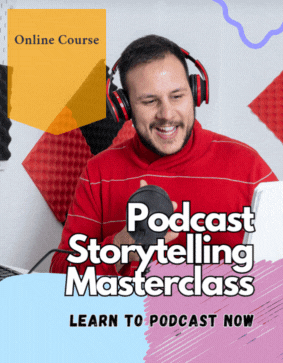Recording a Solo Podcast / Narration | BEHIND THE SCENES
38,420 View
Share this Video
- Publish Date:
- May 25, 2025
- Category:
- Learn to Podcast
- Video License
- Standard License
- Imported From:
- Youtube
What does it look like to record a solo podcast, narration, or voiceover work? How many takes? How many stops and starts? Where to set the mic? Here's a peek behind one of my recent #thursdaythoughts solo podcast episodes.
MASTER YOUR AUDIO
-My audio 101 crash course in beginner audio: https://brianmiller.podia.com (over 4 hours of instruction across 28+ videos, plus bonus resources)
-Use code BETA to get $60 during beta-testing phase, ending soon!
LET'S CONNECT
Instagram: https://instagram.com/bmillermagic
Twitter: https://twitter.com/bmillermagic
LinkedIn: https://linkedin.com/in/bmillermagic
WEEKLY BLOG
http://HumanConnection.blog
BI-WEEKLY PODCAST
https://OneNewPerson.com
MY BOOK ON HUMAN CONNECTION
https://ThreeNewPeople.com
-----------------------------------------
PODCAST MASTERY: How to Make, Market, and Monetize Podcasts
Are you ready to learn how to Make, Market, and Monetize your podcast — even if you're just starting out? This fast-paced, value-packed course will show you exactly how to launch and grow a podcast that attracts listeners, builds authority, and generates income.
You'll learn:
✅ The best equipment to use
✅ How to find engaging guests
✅ How to land sponsorships easily
✅ Ways to grow your audience fast
✅ How to sell your products or services through your podcast
✅ What to do if you don’t have a product (yet!)
Whether you're an entrepreneur, creative, coach, or just have something to say — this course will guide you every step of the way.
👉 Click here to enroll now and start building your podcasting success!
Your voice has power — let the world hear it! 🎧
3 Must-Know Podcasting Tips for Your Show
Creating Engaging Content for Your Audience

Engaging content is the heart of a successful podcast. Focus on topics that resonate with your target audience and address their interests, challenges, and aspirations. Incorporate storytelling techniques to make your episodes more relatable and memorable. Vary your content by mixing interviews, solo episodes, and panel discussions to maintain listener interest. Conduct thorough research to provide valuable insights and accurate information, establishing your podcast as a trustworthy source. Encourage interaction by addressing listener questions and feedback, fostering a sense of community. Consistently delivering content that is both informative and entertaining will keep your audience coming back for more.
Developing a Unique Voice and Style

Establishing a unique voice and style sets your podcast apart and makes it memorable to listeners. Define your podcast’s personality by determining the tone, whether it’s conversational, formal, humorous, or inspiring. Be authentic in your delivery, allowing your genuine personality to shine through and connect with your audience. Develop consistent formatting, including how you introduce topics, transition between segments, and sign off each episode. Incorporate distinctive elements such as catchphrases, specific storytelling techniques, or unique soundscapes that reflect your podcast’s identity. A strong and consistent voice fosters recognition and loyalty, encouraging listeners to return and recommend your podcast to others.
Crafting Compelling Podcast Introductions

Your podcast introduction sets the tone for each episode and captures the listener’s attention from the start. Begin with a brief and impactful summary of the episode’s topic to inform your audience about what to expect. Use a consistent musical theme or jingle to create brand recognition. Introduce yourself and any co-hosts clearly, establishing a personal connection with your listeners. Incorporate a hook, such as a provocative question or an interesting fact, to pique curiosity. A well-crafted introduction not only engages listeners but also reinforces your podcast’s identity and purpose, encouraging them to continue listening.
Frequently Asked Questions
How can I incorporate interviews into my podcast?
Plan your questions in advance, ensure good audio quality for both parties, and create a comfortable environment for your guest. Interviews add variety and different perspectives to your show.
How long should a typical podcast episode be?
Episode length can vary, but typically ranges from 20 to 60 minutes. Choose a duration that suits your content and keeps your audience engaged without overwhelming them.
How do I determine the right tone and style for my podcast?
Consider your target audience and the subject matter. Whether formal, conversational, or humorous, ensure the tone aligns with your content and resonates with your listeners.
What legal considerations should I be aware of in podcasting?
Ensure you have rights to any music or content used, obtain necessary permissions for guest appearances, and adhere to copyright laws. Consider including disclaimers and privacy policies as needed.
How can I monetize my podcast?
Monetization options include sponsorships, advertising, listener donations, merchandise sales, and offering premium content. Choose strategies that align with your audience and content style.
Statistics
- Podcasts with consistent weekly releases are 60% more likely to grow their audience steadily.
- Listeners are 50% more likely to subscribe to podcasts that offer regular episode releases.
- Listener reviews and ratings contribute to a 25% increase in podcast discoverability.
- Podcasts with interactive segments, such as Q&A sessions, see a 25% boost in audience participation.
- Collaborating with other podcasters can lead to a 20% growth in listener base.
- Podcasts utilizing video snippets on social media experience a 20% rise in audience interaction.
- Podcasts promoting their episodes on social media platforms see a 40% boost in new subscribers.
- About 50% of podcast listeners prefer shows that offer a mix of solo and interview episodes.
- Podcasts that include detailed show notes experience a 50% increase in listener engagement.
- Podcasts that utilize analytics to refine content strategies experience a 40% improvement in listener satisfaction.
- Over 80% of podcasters report that having a dedicated website enhances their show’s visibility.
- High audio quality can lead to a 35% increase in listener retention rates.
- Effective use of keywords in podcast descriptions can improve search rankings by 30%.
- Listeners prefer podcast episodes that range between 30 to 45 minutes, with 65% favoring this duration.
- Using transcription services can make podcasts accessible to a wider audience, increasing reach by up to 25%.
- Investing time in marketing can increase a podcast’s audience by up to 50% annually.
External Links
thepodcasthost.com
canva.com
transistor.fm
blog.podomatic.com
help.apple.com
audacityteam.org
anchor.fm
podcastpage.io
podcastcareers.com
socialmediaexaminer.com
apple.com
podcastgrandcentral.com
podcastitalia.com
ahrefs.com
podcastmovement.com
mailchimp.com
optimizingpodcasting.com
How To
How To Select the Right Podcast Hosting Service
Choosing the right podcast hosting service is crucial for the distribution and management of your podcast. Evaluate hosting platforms based on factors like storage limits, bandwidth, and ease of use. Consider whether the service offers built-in analytics to track your podcast’s performance and listener demographics. Look for features such as customizable podcast websites, distribution to major directories, and support for multiple media formats. Pricing is also an important consideration, so compare different plans to find one that fits your budget while meeting your needs. Reputable hosting services like Libsyn, Podbean, and Anchor provide reliable performance and comprehensive tools to help you manage and grow your podcast effectively.
Did you miss our previous article...
https://podcasting-unleashed.com/learn-to-podcast/how-to-structure-your-podcast-episodes-















